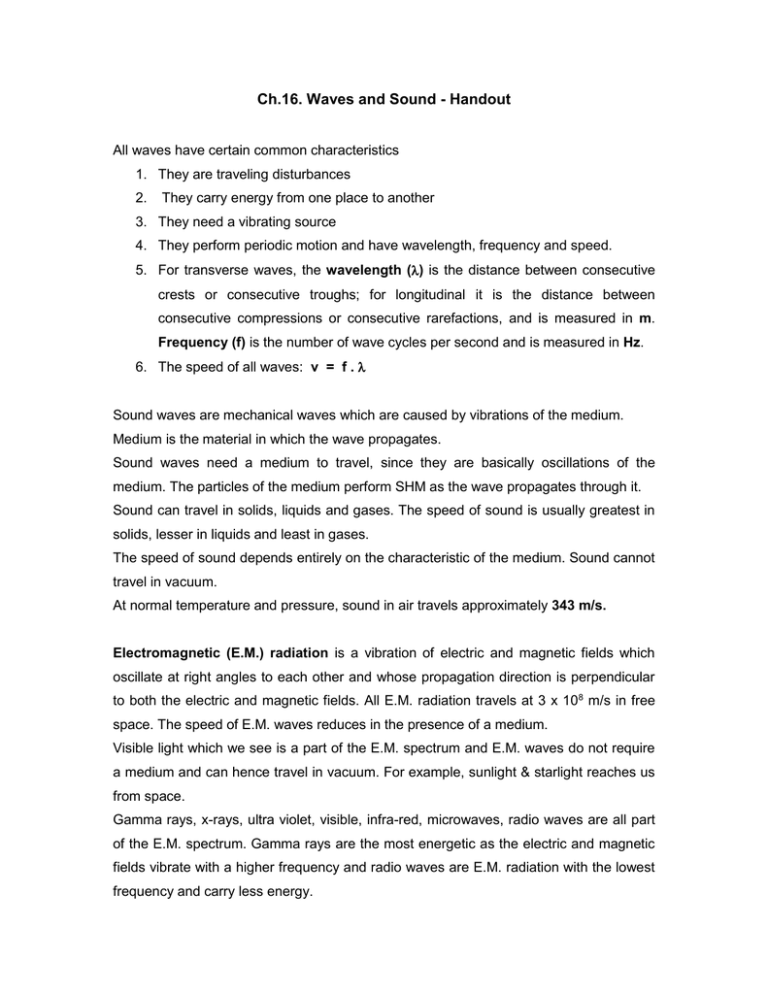Ch.16. Waves and Sound - Handout
advertisement

Ch.16. Waves and Sound - Handout All waves have certain common characteristics 1. They are traveling disturbances 2. They carry energy from one place to another 3. They need a vibrating source 4. They perform periodic motion and have wavelength, frequency and speed. 5. For transverse waves, the wavelength () is the distance between consecutive crests or consecutive troughs; for longitudinal it is the distance between consecutive compressions or consecutive rarefactions, and is measured in m. Frequency (f) is the number of wave cycles per second and is measured in Hz. 6. The speed of all waves: v = f . Sound waves are mechanical waves which are caused by vibrations of the medium. Medium is the material in which the wave propagates. Sound waves need a medium to travel, since they are basically oscillations of the medium. The particles of the medium perform SHM as the wave propagates through it. Sound can travel in solids, liquids and gases. The speed of sound is usually greatest in solids, lesser in liquids and least in gases. The speed of sound depends entirely on the characteristic of the medium. Sound cannot travel in vacuum. At normal temperature and pressure, sound in air travels approximately 343 m/s. Electromagnetic (E.M.) radiation is a vibration of electric and magnetic fields which oscillate at right angles to each other and whose propagation direction is perpendicular to both the electric and magnetic fields. All E.M. radiation travels at 3 x 108 m/s in free space. The speed of E.M. waves reduces in the presence of a medium. Visible light which we see is a part of the E.M. spectrum and E.M. waves do not require a medium and can hence travel in vacuum. For example, sunlight & starlight reaches us from space. Gamma rays, x-rays, ultra violet, visible, infra-red, microwaves, radio waves are all part of the E.M. spectrum. Gamma rays are the most energetic as the electric and magnetic fields vibrate with a higher frequency and radio waves are E.M. radiation with the lowest frequency and carry less energy. Transverse wave: is one in which the disturbance is perpendicular to the direction of travel of the wave. Transverse ways usually propagate in solids, as only solids have the required rigidity. Solids can support both transverse and longitudinal waves. Water waves on the surface like ocean waves are a combination of both transverse and longitudinal waves. Longitudinal wave: is one in which the disturbance is parallel to the line of travel of the wave. Only longitudinal waves can travel in the bulk of liquids and gases. Sound wave in air is longitudinal and the vibrating causes compression and rarefaction of gas molecules which travels as a disturbance in the medium. It can be seen that the speed of sound in a gas increases with increasing temperature and decreases with increasing mass. At 0 0C, v = 331.6 m/sec 0.6 m/sec per 0C The speed of transverse waves in a string is given by v = F (m / l ) F : force or tension in the wire m / L : mass / unit length and is the linear mass density The speed of sound in slender solid bar is given by v = Y Y = Young’s modulus = density and is the mass / unit volume The speed of sound in a liquid v = B B = Bulk’s modulus Power of the wave is the rate at which it transfers energy and is measured in J / sec or Watt. The sound intensity is the power that passes perpendicularly through a surface divided by the area of that surface I = P / Area If a source emits waves uniformly in all directions, then it emits spherical waves and the intensity of sound at a distance ‘r’ from the source is I = P / 4..r2 Decibel (dB) is a measure used when comparing sound intensities and is a dimensionless quantity. The smallest intensity of sound that can be heard by the human ear is called threshold intensity I0 = 10-12 W/m2. At this intensity the intensity level is considered to be zero decibels (0 dB). If I is the intensity of sound then the intensity level is given by = (10 dB) . log(I / I0) I = I0 . 10(/10) When the intensity increases by 10 times, the sound appears only twice as loud. The human ear can hear from 20 to 20,000 Hz frequency. But the sensitivity is not uniform, ears are highly sensitive at 1000 to 5000 Hz and this decreases at other frequencies When an observer or source has relative velocity with respect to the other, then there is a change in frequency or pitch of the sound detected by the observer. This is called the Doppler effect. Source moving toward stationary observer fo = fS [ v / (v – vS)] fS = frequency of the source Source moving away from stationary observer fo = fS [v / (v + vS)] v = velocity of the sound wave vS = velocity of source Observer moving toward stationary source fo = fS [(v + vo) / v] Observer moving away from stationary source fo = fS [ (v - vo) / v] A general case fo = fS [ (v ± vo) / (v fo = frequency detected by observer vS )] vo = velocity of observer
